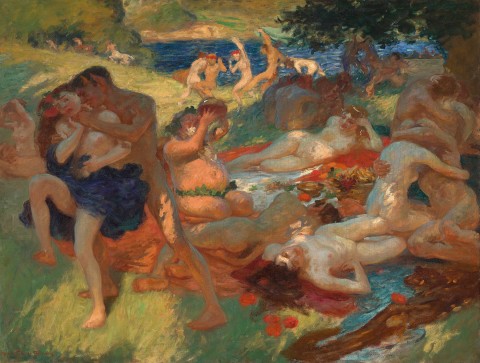BACCHANALE (BACCHANAL), c.1910
RUPERT BUNNY
oil on canvas on composition board
113.0 x 149.5 cm
signed lower left: Rupert C W Bunny
William Frater, Melbourne
Bill Harding, Melbourne, a gift from the above
Thence by decent
Private collection, Melbourne
Salon d’Automne, Grand Palais des Champs–Élysées, Paris, 1 October – 8 November 1910, cat. 183 (as ‘Bacchanale’)
Exhibition of Paintings by Rupert Bunny, Athenaeum Art Gallery, Melbourne, 4 – 15 July 1933, cat. 2 (as ‘Bacchanal’)
L’Art et les Artistes, Paris, November 1910, p. 81
‘Art Notes: The Art of Rupert Bunny’, The Age, Melbourne, 4 July 1933, p. 12
Thomas, D., The Life and Art of Rupert Bunny, A Catalogue Raisonné in Two Volumes, Thames & Hudson, Melbourne, 2017, volume 1: pp. 158, 159, 160 (illus.); volume 2: cat. O333, p. 47
One of the most internationally successful Australian artists of his generation, Rupert Bunny was born in Melbourne and first trained at the National Gallery School, before settling permanently in Paris during the early 1890s where la belle époque was at its height. By 1904, he had become the first Australian artist to receive an honourable mention in the Société des Artistes Francais; was elected a sociétaire of various French exhibiting institutions; and enjoyed the prestige of being the only Antipodean artist until then to have his work acquired by the French State, with Après le bain, c.1904 bought from the New Salon for the Musée de Luxembourg (now the Musée d’Orsay).
First exhibited at the Salon d’Automne in October 1910 alongside such radical works as Matisse’s iconic La Danse, 1910, now in The Hermitage, St Petersburg , Bacchanale (Bacchanal), c.1910 heralded a significant new chapter in Bunny’s oeuvre that featured vibrant mythological paintings conceived in the academic figure tradition, yet ground-breaking in their bold palette and pulsating rhythms. Like his fauvist contemporary, Bunny too was profoundly influenced by the audacity, colour and raw energy of Sergei Diaghilev’s Ballets Russes who had sacked the bastille of Parisian sensibilities the previous year with their scandalous performances of Prince Igor and Cleopatra combining outrageous choreography with exotic tales of sex and violence.1 A daring and then-unprecedented foray into modernism by an Australian artist, indeed Bacchanale may well have been one of the works that prompted fellow expatriate artist, Phillips Fox, to describe Bunny in 1911 as ‘…a little bitten by the post-impressionists.’2 As elaborated by David Thomas in his comprehensive catalogue raisonné of the artist, the bold ‘…flatness of the picture plane and occasional awkwardness in the profiling of the foreground figures’ in Bacchanale further augmented its modern, ‘mural-like effect.’3 Set in the south of France where Bunny was to spend so much time during the coming decades, ‘…the striking play of light and flickering highlights add to the visual excitement. The whorl of figures, of lovers or those exhausted by their pleasures, centres on Silenus, greedily drinking from a flask of wine. In the distant centre, a group dances with Bacchic exuberance, while on the hill slope to the left, centaurs gallop in pursuit of a luckless nymph into the forest. The painting expresses the frenzied pleasure and intoxicated chaos that is part of the Bacchic rite, celebrated in honour of Bacchus, god of wine.’4
Interestingly, Bacchanale was originally gifted by Bunny to fellow artist Jock Frater with whom he shared a close friendship in Melbourne from the 1920s onwards. Both participated in group exhibitions with the Twenty Melbourne Painters from 1927; the Contemporary Art Group from 1931; Contemporary Art Society 1939; and the Victorian Artists Society, and also enjoyed regular social catch ups together at Café Francois, and later Mario’s in the 1930s, as well as Bunny’s South Yarra flat. Several years later, Frater subsequently gifted the work to Bill Harding, a student whom he mentored from the 1950s until Frater’s death in 1974 through weekly painting sessions at Lucerne Cres, Alphington, Bill’s studio in Templestowe, or en plein air in favourite localities.
1. Thomas, D., The Life and Art of Rupert Bunny, A Catalogue Raisonné in Two Volumes, Thames & Hudson, Melbourne, 2017, volume 1, p. 158, volume 2: cat. O333, p. 47
2. Fox, letter to Hans Heysen, 13 September 1911
3. Thomas, op.cit.
4. Ibid.
VERONICA ANGELATOS
